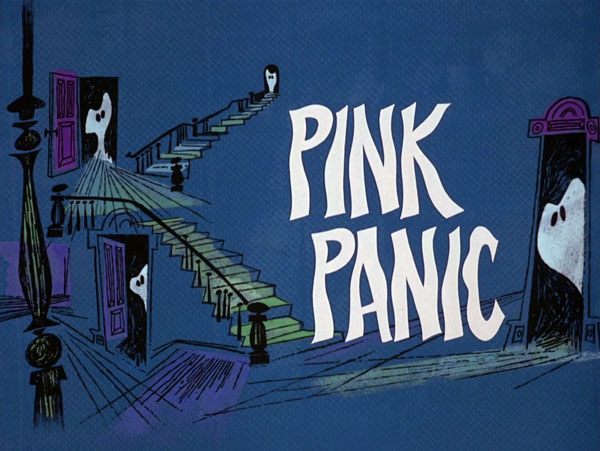
Step inside the Dead Dog Hotel with the Pink Panther (if you dare) in this week’s animator breakdown!
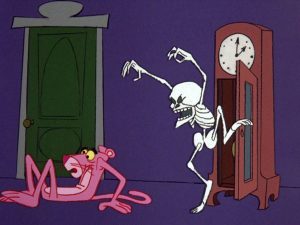 Pink Panic was the 27th entry in the first run of Pink Panther cartoons released from 1964-69. In an era where animation championed verbose writing, especially on television, the Pink Panther cartoons mainly used pantomime, supplied by the studio’s head writer John W. Dunn. By the time Pink Panic was in production, Hawley Pratt served as the series’ main director. He was a worthy successor, having served as Friz Freleng’s background/character layout artist at Warner Bros. (where, on occasion, he acted as co-director).
Pink Panic was the 27th entry in the first run of Pink Panther cartoons released from 1964-69. In an era where animation championed verbose writing, especially on television, the Pink Panther cartoons mainly used pantomime, supplied by the studio’s head writer John W. Dunn. By the time Pink Panic was in production, Hawley Pratt served as the series’ main director. He was a worthy successor, having served as Friz Freleng’s background/character layout artist at Warner Bros. (where, on occasion, he acted as co-director).
Eight animators are credited on the film—more than usual for a DePatie/Freleng cartoon—and each are assigned their own sequences. Manny Perez handles the opening scenes of the Pink Panther outside in the storm in the deserted Western frontier town of Dead Dog. He spots a hotel at an opportune time after the canopy of his umbrella is torn from the wind pressure. Perez’s animation continues when the Panther enters the haunted hotel and attempts to sign the registry with an uncooperative fountain pen that spurts ink onto his face.
Manny Gould is not given much footage in the film. He animates the Panther wiping his face on a covering sheet rested on a chair. A pair of threatening eyes appears on the cover and follows him up to a vacant bedroom in the form of the chair. The ghostly chair sits behind the Panther and he trips over it twice before kicking it down the stairs.
In a section animated by Don Williams—who spent much of his long career on-staff at DePatie-Freleng before his death in 1980—the ghost finds the Panther in the bathroom, ready to frighten him outside of the shower but the Panther has finished his bath and uses the ghost as a towel. (This animation was reused for In the Pink, released a few months after Pink Panic— and was attributed to Norm McCabe in the latter cartoon.)
Williams’ animation resumes as the Panther prepares for sleep and a skeleton rests beside him, blowing out both of their candles at the same time. When the room goes dark, the Panther lets out a sharp scream of terror (lifted from a 1957 Robert McKimson-directed Daffy Duck cartoon, Boston Quackie) and he runs out into the hall, with the skeleton chasing after him. The Panther finds a room and slams the door; the skeleton runs into it with his bones rattling and falls into pieces on the floor.
Warren Batchelder, former assistant animator to Virgil Ross at Warner Bros., is given a brief section when the Panther uses the ghost as a parachute and battles with the skeleton inside of its sheet. Not much information is known about John Gibbs, but his career as a full-fledged animator seems to begin with the DePatie-Freleng studio during the mid-1960s. Gibbs animates an extensive sequence where the Panther is up against the ghost who assumes the role of a Western gunslinger.
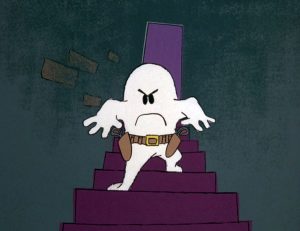 Verne Harding and Bob Matz mostly handle the last minute of the cartoon. Harding animates the Panther inflating and bursting the ghost like a paper bag, but this backfires when an army of tiny phantoms chase after him. Matz’s work is seen during the scuffle inside the grandfather clock, and when the commotion awakens the local sheriff. Harding gets the final scene, when the Panther and the two ghouls are arrested.
Verne Harding and Bob Matz mostly handle the last minute of the cartoon. Harding animates the Panther inflating and bursting the ghost like a paper bag, but this backfires when an army of tiny phantoms chase after him. Matz’s work is seen during the scuffle inside the grandfather clock, and when the commotion awakens the local sheriff. Harding gets the final scene, when the Panther and the two ghouls are arrested.
Jacques Rupp is credited as the layout artist on Pink Panic. Rupp was a former layout artist for Disney, for Lady and the Tramp (1955) andspecial segments of the Disneyland television program (“Man in Space” [1955] and “Magic Highway U.S.A” [1958]). Rupp evidently contributed to the Disneyland theme park in significant ways—he designed the costumes for employees on the Jungle Cruise and Canal Boat Ride attractions, and helped develop the Matterhorn ride. After his work for Disney, he served as an art director on Hanna-Barbera’s first feature Hey There It’s Yogi Bear (1964) and worked in layouts at Cambria Studios on The New Three Stooges television series before joining DePatie-Freleng.
The draft for Pink Panic originated from the collection of Pete Alvarado, the credited background painter on the cartoon. However, a few credits are missing on the document. Thankfully, Mike Kazaleh and Greg Duffell, both avid fans of the DePatie-Freleng output and its animators, used their sharp analysis to fill in the missing gaps.
Enjoy!
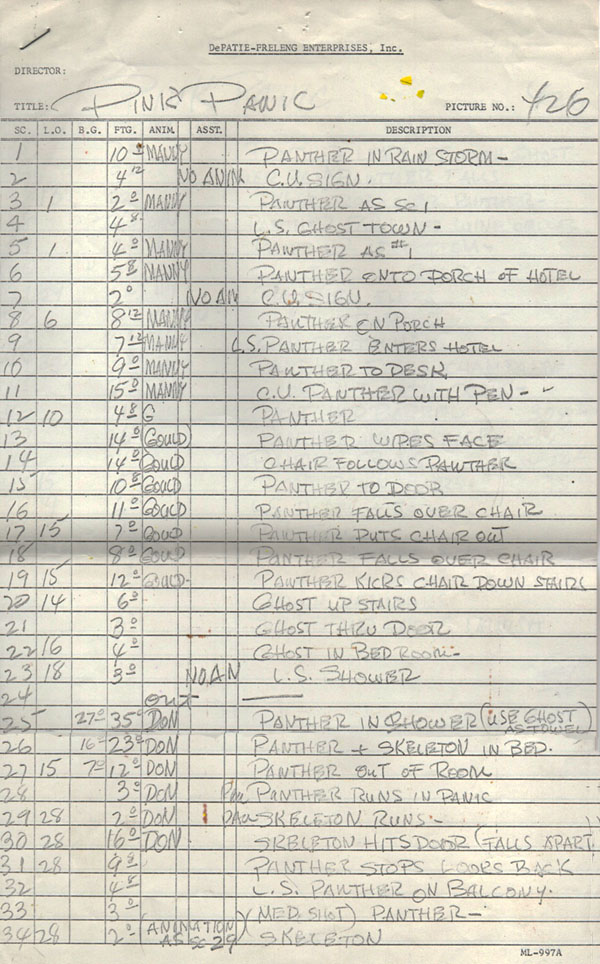
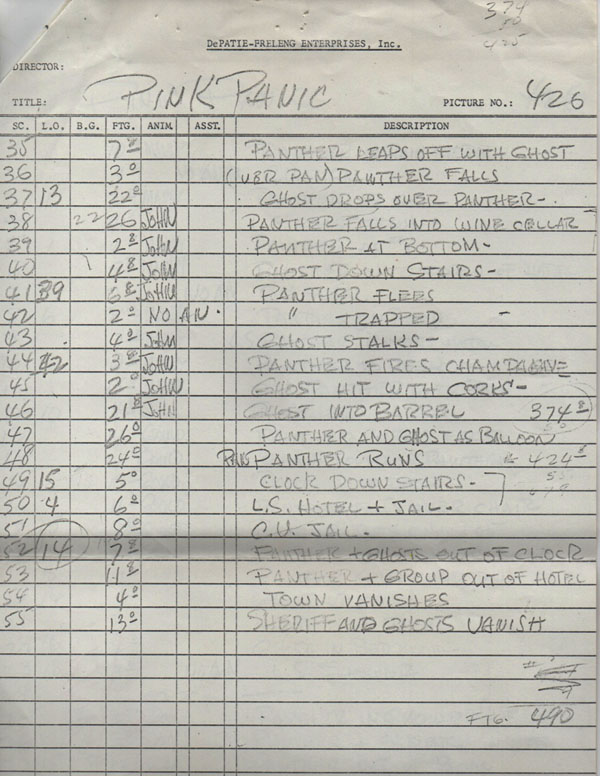
(Thanks to Jerry Beck, Greg Duffell and Mike Kazaleh for their help.)


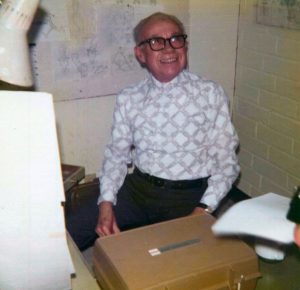
 DEVON BAXTER is a film restoration artist, video editor, and animation researcher/writer currently residing in Pennsylvania. He also hosts a
DEVON BAXTER is a film restoration artist, video editor, and animation researcher/writer currently residing in Pennsylvania. He also hosts a 



















































































Pink Panic is one of my favorite Pink Panther shorts! I learned a lot.
Probably one of the best ending to Pink Panther cartoon.
Good writeup, Devon! This is a good Panther short to cover.
Which “spooky” Pink Panther cartoon is regarded as being better, “Pink Panic” or “Pink Plasma”?